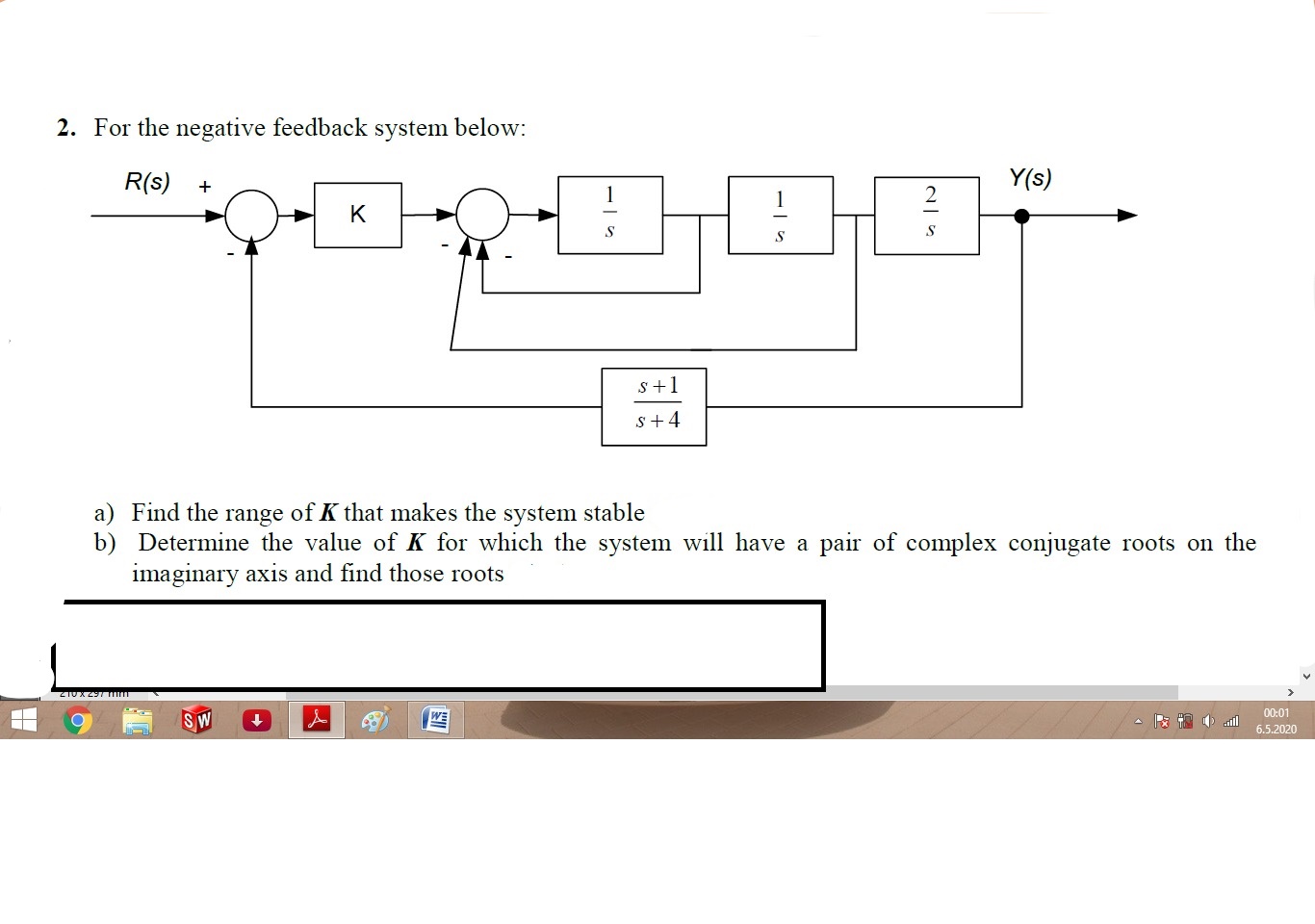
Introductory Circuit Analysis (13th Edition)
13th Edition
ISBN: 9780133923605
Author: Robert L. Boylestad
Publisher: PEARSON
expand_more
expand_more
format_list_bulleted
Concept explainers
Question
thumb_up100%

Transcribed Image Text:R(s)
Y(s)
K
s+1
s+4
a) Find the range of K that makes the system stable
b) Determine the value of K for which the system will have a pair of complex conjugate roots on the
imaginary axis and find those roots
Expert Solution
This question has been solved!
Explore an expertly crafted, step-by-step solution for a thorough understanding of key concepts.
This is a popular solution
Trending nowThis is a popular solution!
Step by stepSolved in 3 steps with 11 images

Knowledge Booster
Learn more about
Need a deep-dive on the concept behind this application? Look no further. Learn more about this topic, electrical-engineering and related others by exploring similar questions and additional content below.Similar questions
- Consider a circuit with three capacitors connected in series. The capacitances are C₁ = 2.3 μF, C₂ = 1.8 μF, and C3 = 5.1 µF. What is the equivalent capacitance (in µF) of the three capacitors? 0.811 X x Are the capacitors connected in series or parallel? Remember that for capacitors in series, 0.677 C₁ = 2.3 μF 1 C3 = 5.1 μF eq = If a 17.0 V potential is applied to the circuit, what is the charge (in µC) of each capacitor? 14.33 ✓ Correct. We know the equivalent capacitance from the previous question. We also know that the charges on capacitors connected in series are the same. Thus, we can multiple the equivalent capacitance by the applied potential to determine the charge. µC If we now connect C₁ in series to C₂ and C3 in parallel, what is the equivalent capacitance (in µF)? (Note: C₁ = 2.3 µF, C₂ = 1.8 µF, and C3 = 5.1 µF.) C₂ = 1.8 μF 1 Ceq 1 ¡C; while in parallel: Ceq = = ΣC, UF X x Are the capacitors connected in series or parallel? Remember that for capacitors in series, -¹…arrow_forwardDO NOT COPY FROM OTHER WEBSITES. Correct and detailed answer will be Upvoted else downvoted. Thank you!arrow_forwardRC circuit after the capacitor is charged, the switch is moved to dischsrge. The capacitor discharges through the resistance and voltage across the capacitor. Find time (t) if V=60V, R=1.0kΩ, & C=5µF. a. Vc=15V b. Vc=5.0Varrow_forward
arrow_back_ios
arrow_forward_ios
Recommended textbooks for you
 Introductory Circuit Analysis (13th Edition)Electrical EngineeringISBN:9780133923605Author:Robert L. BoylestadPublisher:PEARSON
Introductory Circuit Analysis (13th Edition)Electrical EngineeringISBN:9780133923605Author:Robert L. BoylestadPublisher:PEARSON Delmar's Standard Textbook Of ElectricityElectrical EngineeringISBN:9781337900348Author:Stephen L. HermanPublisher:Cengage Learning
Delmar's Standard Textbook Of ElectricityElectrical EngineeringISBN:9781337900348Author:Stephen L. HermanPublisher:Cengage Learning Programmable Logic ControllersElectrical EngineeringISBN:9780073373843Author:Frank D. PetruzellaPublisher:McGraw-Hill Education
Programmable Logic ControllersElectrical EngineeringISBN:9780073373843Author:Frank D. PetruzellaPublisher:McGraw-Hill Education Fundamentals of Electric CircuitsElectrical EngineeringISBN:9780078028229Author:Charles K Alexander, Matthew SadikuPublisher:McGraw-Hill Education
Fundamentals of Electric CircuitsElectrical EngineeringISBN:9780078028229Author:Charles K Alexander, Matthew SadikuPublisher:McGraw-Hill Education Electric Circuits. (11th Edition)Electrical EngineeringISBN:9780134746968Author:James W. Nilsson, Susan RiedelPublisher:PEARSON
Electric Circuits. (11th Edition)Electrical EngineeringISBN:9780134746968Author:James W. Nilsson, Susan RiedelPublisher:PEARSON Engineering ElectromagneticsElectrical EngineeringISBN:9780078028151Author:Hayt, William H. (william Hart), Jr, BUCK, John A.Publisher:Mcgraw-hill Education,
Engineering ElectromagneticsElectrical EngineeringISBN:9780078028151Author:Hayt, William H. (william Hart), Jr, BUCK, John A.Publisher:Mcgraw-hill Education,

Introductory Circuit Analysis (13th Edition)
Electrical Engineering
ISBN:9780133923605
Author:Robert L. Boylestad
Publisher:PEARSON

Delmar's Standard Textbook Of Electricity
Electrical Engineering
ISBN:9781337900348
Author:Stephen L. Herman
Publisher:Cengage Learning

Programmable Logic Controllers
Electrical Engineering
ISBN:9780073373843
Author:Frank D. Petruzella
Publisher:McGraw-Hill Education

Fundamentals of Electric Circuits
Electrical Engineering
ISBN:9780078028229
Author:Charles K Alexander, Matthew Sadiku
Publisher:McGraw-Hill Education

Electric Circuits. (11th Edition)
Electrical Engineering
ISBN:9780134746968
Author:James W. Nilsson, Susan Riedel
Publisher:PEARSON

Engineering Electromagnetics
Electrical Engineering
ISBN:9780078028151
Author:Hayt, William H. (william Hart), Jr, BUCK, John A.
Publisher:Mcgraw-hill Education,